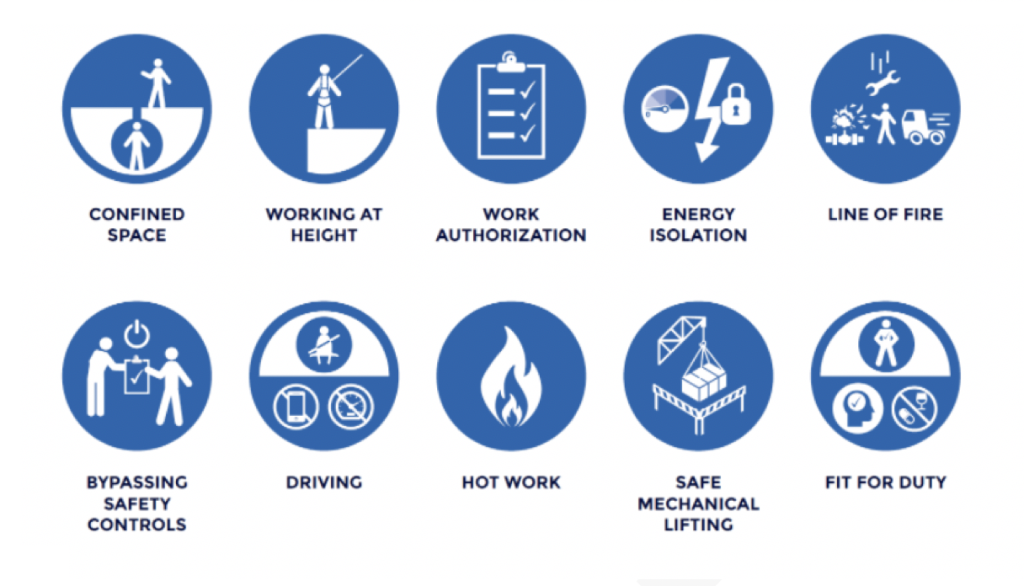
Changing the view on safety rules
November 24, 2021
By
Paula Campkin
Launched in 2018 as an industry-wide standard, the Life Saving Rules were established through collaboration with industry, using data-driven research.

Icons depicting Energy Safety Canada’s 10 Life Saving Rules. (Submitted)
Two hundred and forty.
That’s the number of work-related fatalities in the Canadian oil and gas industry from 2001 to 2017 that align with one of the Life Saving Rules.
That’s 240 fatalities that Energy Safety Canada and industry partners believe could have been prevented if the Life Saving Rules had been in place and controls effectively implemented.
Their importance is realized when you consider the impact that a single death has on family, friends, co-workers, and the community.
Launched in 2018 as an industry-wide standard, the Life Saving Rules were established through collaboration with industry, using data-driven research.
The rules address the 10 areas with the highest incidents of serious injury or death based on data from workers’ compensation boards.
The 10 Life Saving Rules are:
- Confined Space
- Working at Height
- Work Authorization
- Energy Isolation
- Line of Fire
- Bypassing Safety Controls
- Driving
- Hot Work
- Safe Mechanical Lifting
- Fit for Duty.
Importantly, the Life Saving Rules are intended to empower workers. Not only are they designed to help guide effective work planning and hazard identification, but also to empower workers to pause when faced with high-risk activities and intervene if they observe unsafe situations or behaviours.
Instead of “you shall” rules, the Life Saving Rules are written as “I” statements to emphasize the notion that everyone owns safety and to help create a sense of personal accountability.
Why standardization?
Aligning industry efforts ensures a consistent approach in the prevention of serious injuries and fatalities. It also makes it easier for workers to know what is expected when they move from one worksite to another.
Standardization is a shared vision amongst Energy Safety Canada and its Safety Standards Council, which consists of 14 major energy players representing all sectors of the industry.
Working closely with Energy Safety Canada, the Safety Standards Council was the driving force for the oil and gas industry to adopt the standardized set of Life Saving Rules.
When the Life Saving Rules were introduced, many companies already had their own health and safety rules designed to save lives. In the interest of supporting an industry-wide standard, many put aside their variations and adopted Energy Safety Canada’s 10 Life Saving Rules.
Having said that, it’s not about losing your company perspective; rather, it’s about a unified approach to drive improved safety performance.
Standardization of the Life Saving Rules reduces redundancy and lines up with an international effort, as Energy Safety Canada ensured alignment with the nine rules developed by the International Association of Oil and Gas Producers (IOGP).
A shift in perspective
The Life Saving Rules are an opportunity to shift industry’s perspective on workplace safety from punitive-based to solutions-focused.
This shift requires executives, managers, and supervisors to use the rules proactively.
For example:
- discussing the applicable rules before the work begins
- engaging the front line to identify areas or tasks where Life Saving Rules might apply
- approaching incident investigations from the perspective of “what can we learn from this?” rather than “who is to blame?”
This enables a more collaborative and learning focused approach where both the system and the behaviours are examined. In this way, employers can create an environment where non-compliances are reported and discussed openly to better understand the issues from all perspectives.
From documents, webinars, microlearning and toolbox talks (available in English and French) to an active community of practice where lessons learned are openly discussed, energy companies that adopt the Life Saving Rules are supported in all stages of implementation and management.
Interested in learning more? The Case for Change is a good starting point and is one of many resources available at EnergySafetyCanada.com.
Paula Campkin is vice-president of operations and the Safety Centre of Excellence at Energy Safety Canada in Calgary, Alta.